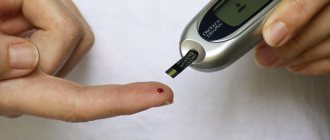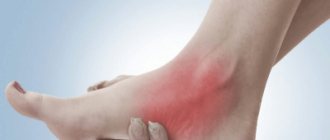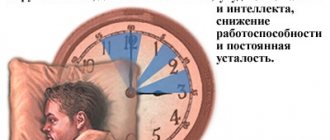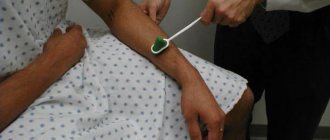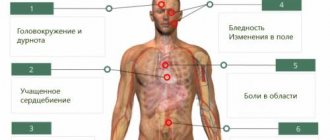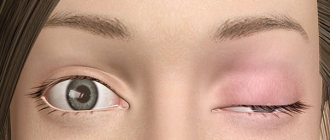Causes
Paresthesias are sensory disturbances that occur when the nerve plexuses and endings of the spinal nerve roots are affected. Most often they affect the upper and lower extremities, face, neck, and oral cavity. There are the following types of paresthesia: physiological (temporary) and pathological (chronic).
Physiologically determined causes of paresthesia of the arms, legs and face can be the following conditions:
- Staying in a fixed position for a long time. This explains the frequent occurrence of paresthesias of the upper and lower extremities at night: a person uncontrollably finds himself in an uncomfortable position, pressing an arm or leg, and wakes up with the feeling of goosebumps crawling on the skin.
- Trauma or pressure on a specific area of the body that causes mechanical irritation of superficial nerves.
- Wearing inappropriate shoes. This problem is often faced by women who choose shoes with tapered toes, high heels, and 1-2 sizes smaller. Tight shoes provoke compression of nerve endings and poor circulation, causing the development of paresthesia of the lower extremities.
Paresthesia during pregnancy
- Pregnancy. The pregnancy period is characterized by a serious restructuring of a woman’s entire body, so paresthesia at this time is not uncommon. When localized in the lower back and legs, sensory impairment is usually caused by increasing pressure from the fetus on the nerve endings in the lumbosacral area. Hormonal changes that occur during pregnancy can also trigger the appearance of paresthesia.
Impaired sensitivity can be caused by pathological processes occurring in the body. Among them, it is worth highlighting the following diseases and disorders:
- Spinal diseases. Displacement of the vertebrae, hernia and protrusion of intervertebral discs, osteochondrosis, scoliosis, kyphosis, lordosis, oncological processes - all this can lead to changes in sensitivity. Depending on the location of the lesion, paresthesia may affect the upper or lower extremities, neck, and head.
- Radiculopathy. This pathology is also known as radicular syndrome. It develops as a result of compression of the spinal nerve roots and is manifested by pain, numbness and paresthesia.
- Brain lesions. Neoplasms, abscesses, degenerative processes and other pathologies of the brain provoke disturbances in the functioning of the central nervous system and can cause the development of paresthesia throughout the body.
!
If paresthesia affects only one half of the body and the person cannot smile symmetrically, pronounce a simple sentence coherently and raise both arms at the same time, it is important to call an ambulance as soon as possible.
These symptoms are signs of stroke, a pathological condition that poses a serious threat to health and life. Remember: in such cases, minutes count, so it is important that the patient receives medical care in a timely manner.
Leg paresthesia: symptoms
- Polyneuropathy. These pathological conditions develop against the background of alcoholism, diabetes mellitus, cirrhosis, uremia, etc. They are characterized by damage to peripheral nerves and impaired trophism of the distal parts of the lower and upper extremities.
- Neuroses. Paresthesia in neurosis usually develops in response to a serious shock (for example, loss of loved ones, dismissal, psychological trauma), chronic stress, internal psychological conflicts, etc. They usually appear in combination with other symptoms of neuroses - irritability, apathy, tearfulness, panic attacks, insomnia and etc.
- Endocrine diseases. Disruption of the functioning of the endocrine glands provokes a number of changes in the human body, one of which may be a decrease in sensitivity. For example, paresthesia often occurs as a complication of diabetic polyneuropathy.
- Vascular diseases. Violation of the normal functioning of blood vessels leads to a decrease in the trophism of tissues and nerve endings, causing a violation of their sensitivity. Most often, this clinical picture affects the lower extremities. Its development can be caused by obliterating endarteritis, atherosclerosis, thrombosis, thrombophlebitis, phlebitis. Also quite often, sensory impairment is observed with varicose veins of the lower extremities.
Expert opinion
Despite the fact that paresthesia of the legs is a common consequence of diseases of the veins and arteries of the lower extremities, vascular pathologies can provoke sensory disturbances in other parts of the body. For example, numbness and tingling on one side of the face, combined with throbbing pain in the temple and characteristic flashes of light before the eyes, may be a sign of vasospasm, which is observed in migraines.
Vascular surgeon, phlebologist
Osipova Ekaterina Yakovlevna
- Hypovitaminosis. The presence of paresthesia may be a symptom of B vitamin deficiency.
Symptoms of paresthesia of the face and other locations
The classic triad of all paresthesias:
- numbness of varying degrees of severity;
- tingling;
- a feeling of “crawling goosebumps” on the surface of the skin.
Sometimes in the area of the skin that is innervated by the irritated nerve ending, itching of varying intensity and pain may occur.
Most often, paresthesia occurs in the following localization:
- feet (especially on the back surface);
- brushes;
- neck (especially its lateral surface);
- head. It should be borne in mind that symptoms of facial paresthesia are often combined with signs of paresthesia of the scalp. On the other hand, discomfort due to nerve irritation can affect individual locations - the mucous membrane of the mouth and tongue or the mucous membrane of the nose and pharynx, although neighboring organs and tissues will not undergo any sensory changes.
If paresthesia is observed regularly over a period of time, trophic disorders may occur in the area of sensitivity failure (due to impaired tissue nutrition). They signal increasing irritation of the nerve, and can also act as a “red flag” warning of the onset of serious organic disorders on the part of the affected nerve.
Treatment
The attending physician chooses how to treat paresthesia depending on the cause that caused it. For example, therapy for varicose veins involves taking phlebotonics and angioprotectors; The patient may also be recommended to undergo surgical removal of the affected vessels. Normaven® Leg Cream can be used as an additional remedy in the treatment of varicose veins. Clinical studies have shown that using the product for three months can reduce the feeling of heaviness and fatigue in the lower extremities, swelling, cramps, and also reduce the severity of the vascular pattern.
Means for the treatment of leg paresthesias
A view from the point of view of neurology and psychiatry
Dysesthesia is a perversion of susceptibility, characterized by the occurrence of pain in areas of impaired sensitivity, which arise as a response to a slight tactile stimulus or spontaneously.
It can be observed when the central or peripheral nervous system is damaged. Spontaneous or caused for certain reasons (for example, by touch) can be perceived as a pain syndrome (for example, as temperature) and so on:
This concept means perverted disturbances of sensitivity, in other words, the loss of the usual correspondence between an objective stimulus and its biased assessment: when the patient feels an object, it seems larger than its real size.
Sometimes a patient feels an external irritant incorrectly: not in the place or side where it was inflicted, but on the opposite side, let’s say an injection was made in the left thigh, but it is felt in the right.
With tabes dorsalis, there is often a slowdown in the conduction of pain, for example, with a painful injection, the patient does not react to it at all, and after the doctor or someone else, thinking that this is a state of deep anesthesia, moves on to the next steps, new injections with In order to find out its limits, the patient suddenly experiences a feeling of severe pain.
In all of these types of violations, an incorrect assessment of external irritation occurs.
Dysesthesia from a neurological point of view is a disorder (pathology) of sensitivity that occurs as a result of damage to the sensory nerve, pathways, dorsal horns or in the roots of the spinal cord. The penultimate parameter relates only to temperature and pain sensitivity; muscle and joint sensitivity are not affected in this case.
The appearance of dysesthesia from the point of view of psychiatry is similar, but has a different configuration of pathologies of sensitivity and susceptibility. They are caused by a mental abnormality or are symptoms of mental disorders.
Generally speaking, there is no exhaustive and generally accepted classification of disorders of elementary receptivity and sensitivity in modern psychiatry.
Prevention
To prevent the appearance of paresthesias, it is recommended to promptly treat the underlying disease that provokes their development, as well as stop drinking alcoholic beverages, avoid prolonged stays in uncomfortable positions, and wear high-heeled shoes less often.
Sources:
- Alekseeva O. A. Nocturnal paresthesia syndrome with myofascial pain syndrome. // Kazan Medical Journal. – 2007. – T. 88. – No. 5. – P. 431-434.
- Pribytkov D. L., Supilnikov A. A., Starostina A. A., Boriskin P. V., Antipov E. V. Study of the microvasculature in the lower extremities in patients with obliterating endarteritis. // Bulletin of the Medical Institute “Reaviz”: rehabilitation, doctor and health. – 2018. – No. 1. – P. 58-62.
- Demidova I. Yu., Khramilin V. N., Ignatova O. Yu. Diabetic distal polyneuropathy. // Endocrine surgery. – 2008. – No. 1 (2). – pp. 29-39.
- Podchufarova E. V. Discogenic lumbosacral radiculopathy. // Neurology, neuropsychiatry, psychosomatics. – 2010. – P. 22-29.
- Babanov S. A., Tatarovskaya N. A., Baraeva R. A. Occupational chronic lumbosacral radiculopathy. // Difficult patient. – 2013. – T. 11. – No. 12. – P. 23-30.
For an accurate diagnosis, contact a specialist.
Diagnosis of paresthesia
In most cases, paresthesia of the lips and tongue, hands, feet and other parts of the body is easy to diagnose. The doctor asks the patient about the following nuances:
- the nature of unusual sensations;
- their frequency;
- what the patient associates with numbness, tingling and other atypical sensations;
- whether similar sensations have appeared before;
- whether the patient works with harmful substances (salts of heavy metals, nitrates and organic solvents are especially important);
- whether there is any consumption of alcoholic beverages.
You should also find out if there are any medical procedures in your medical history (this is how paresthesia may occur after the removal of a wisdom tooth).
In addition, the doctor should check skin sensitivity not only in those areas of the body that are subject to paresthesia, but also in neighboring ones. An examination of the skin will be informative, during which the following will be noted:
- pale skin;
- hair loss;
- a decrease in local temperature, which can be diagnosed even by touch.
In a number of cases, it was thanks to paresthesia that complex diseases were diagnosed. Therefore, you should carefully determine the causes of paresthesia of the fingers, toes and torso, since behind harmless sensations that may not cause any particular inconvenience to the patient, the same diabetes mellitus can be hidden. For any, even minor, sensitivity disorders, a comprehensive examination is necessary.

